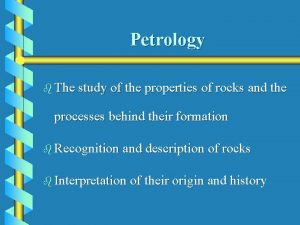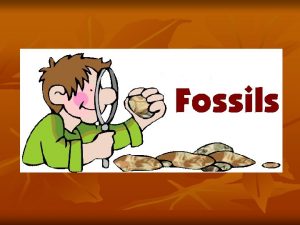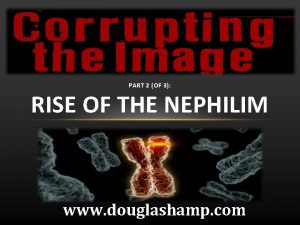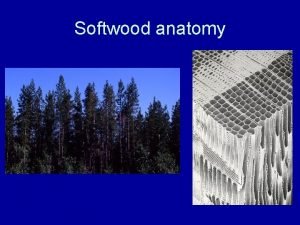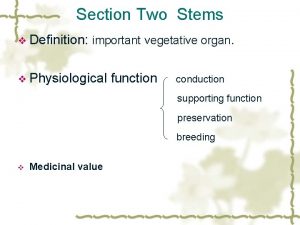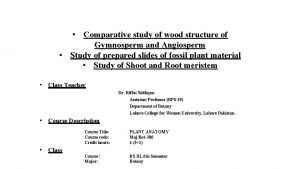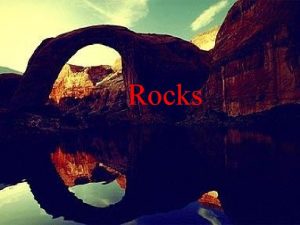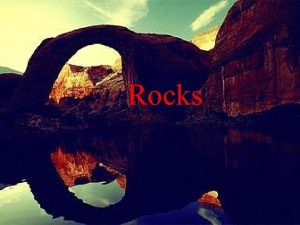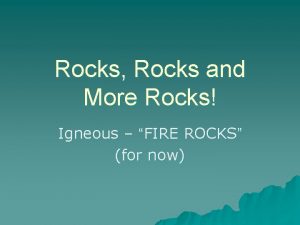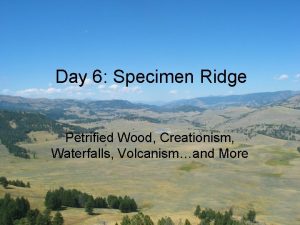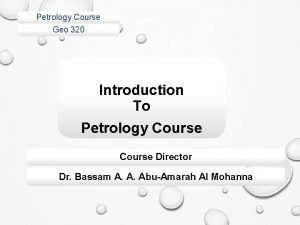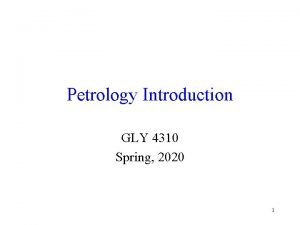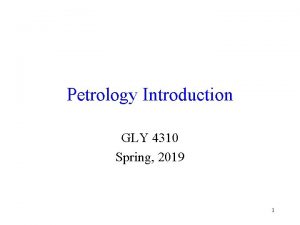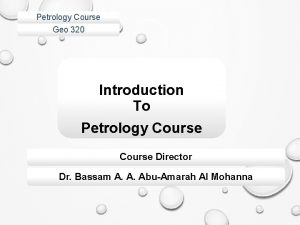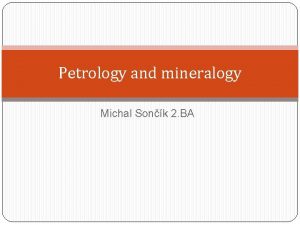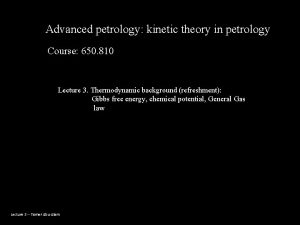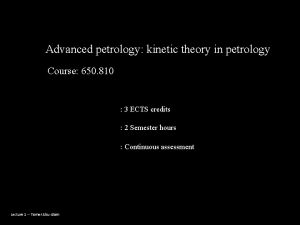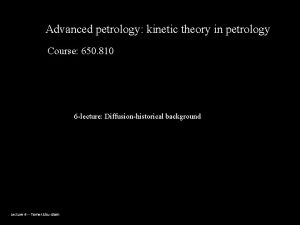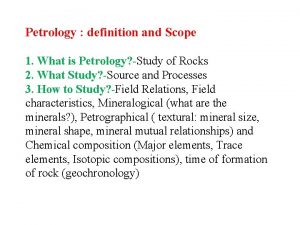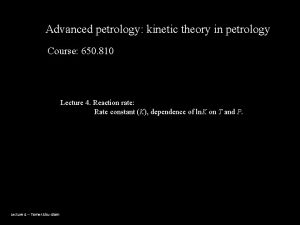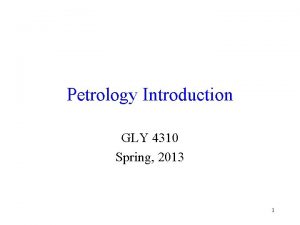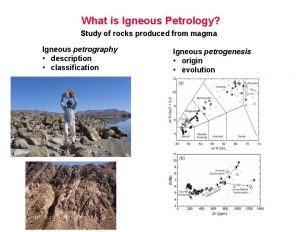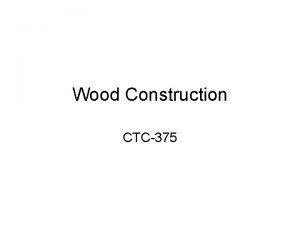Petrology The Study of Rocks Example Petrified wood


























- Slides: 26

Petrology The Study of Rocks Example: Petrified wood = wood turned to rock At Museum of Natural History the piece in front is 200 Million Years Old.

Rock Naturally occurring solid aggregate of minerals Aggregate - a collection of items Therefore a rock is a group of minerals Polymineralic – Many Minerals Monomineralic – 1 Mineral

Lithosphere Rock Sphere Lithos = Rock / Stone If the earth was the size of a basketball it would be paper thin.

3 Types of Rock Igneous (fire) Sedimentary (Sediment) Metamorphic (Morph)

Igneous Cooling or Solidification Of Molten Rock. (Magma or Lava) Ignis - Fire Ignite – Making Fire

Cooling Speeds Intrusive – (Magma) Cools inside the Earth. Cools Slowly Grows Large Crystals The longer it has to cool The larger the crystals Can Grow.

Cooling Speeds Extrusive - (Lava) Cools outside the Earth Cools Fast Small or no crystals Glassy (rapid cooling) Vesicular ( gas pockets) Fine grained (not visible)

Igneous Rock Scheme

Interesting facts Bottom 95 % of Lithosphere Most common rock Over 700 Types Absolute Age can be identified (Radioactive dating) Early Tools

Sedimentary Rocks Formed from pieces of sediment that get recombined to make a new rock. Sediment – Broken up pieces of rock. Form At Earth's surface & within bodies of water

Clastic Made of fragments/pieces Categorized by grain size Conglomerate (large) Sandstone (Sand size) Shale (Clay - smallest)

Chemical When dissolved sediment comes out of H 20 Crystalline Precipitates (rains out) (~Sugar falling out of cold coffee) Evaporites (water leaves) (~Salt left after evaporation)

Precipitation in Caves. Stalactites Hang tight Stalagmites Might Trip Columns White house

Organic 1) Chemical – Dissolved calcite precipitates out to form limestone. 2) Bioclastic – “Living pieces” Limestone - Compaction of shells Coal – Compacted plant remains Limestone – Can form both ways


Fossils in Sedimentary Rocks An organism dies, gets buried under sediment and eventually preserved in the rock.

Interesting Facts Most common surface rock. Only 5% of lithosphere (top 5%) Layers show relative age (relative dating) Holds : Coal, Fossil Fuels, Water and more Most common rock for fossils to be found

Metamorphic Rocks that “changed” due to Heat and Pressure. Morph – to transform or change Granite Gneiss

Foliated Layered (folded) Mineral Alignment – Minerals line up in layers. Rock has physical layers. Banding – Minerals separate by type. Rocks have colored layers.

Non Foliated No distinct mineral alignment or layers. Break into angular pieces Named based on size And what rock they came from.

Types of Metamorphism Contact Metamorphism – heat is directly applied to the rock to change it (Lava or magma)

Types of Metamorphism Regional Metamorphism – An entire area is put under so much Pressure it changes the rock. ex - rock under a mountain range.

Metamorphic Rocks Scheme

Interesting Facts The rock is made harder by the heat and pressure So it is great for buildings. (limestone ~ chalk Marble ~ Lincoln Memorial) Granite turns to Gneiss (Nice counter tops… no they are granite)

Rock Cycle

Rock Cycle Shows how any rock type with the proper conditions can turn into any other rock type. (including a new version of itself) Any rock can break down into sediment and reform as a sedimentary rock Any rock can melt into molten rock and reform as an igneous rock Any rock can be given heat and pressure and reform as a metamorphic rock
 Petrology is the study of
Petrology is the study of Cobalt petrified wood location
Cobalt petrified wood location Metamorphic rocks
Metamorphic rocks Igneous rock to metamorphic rock
Igneous rock to metamorphic rock Petrified remains
Petrified remains Who was king og of bashan
Who was king og of bashan How is intrusive igneous rock formed
How is intrusive igneous rock formed Naviance lasa
Naviance lasa Softwood anatomy
Softwood anatomy Roots vegetative propagation
Roots vegetative propagation Esharenet
Esharenet Esau wood poem
Esau wood poem Wood wood teenager
Wood wood teenager Hát kết hợp bộ gõ cơ thể
Hát kết hợp bộ gõ cơ thể Frameset trong html5
Frameset trong html5 Bổ thể
Bổ thể Tỉ lệ cơ thể trẻ em
Tỉ lệ cơ thể trẻ em Chó sói
Chó sói Thang điểm glasgow
Thang điểm glasgow Hát lên người ơi
Hát lên người ơi Các môn thể thao bắt đầu bằng tiếng nhảy
Các môn thể thao bắt đầu bằng tiếng nhảy Thế nào là hệ số cao nhất
Thế nào là hệ số cao nhất Các châu lục và đại dương trên thế giới
Các châu lục và đại dương trên thế giới Công thức tiính động năng
Công thức tiính động năng Trời xanh đây là của chúng ta thể thơ
Trời xanh đây là của chúng ta thể thơ Cách giải mật thư tọa độ
Cách giải mật thư tọa độ Làm thế nào để 102-1=99
Làm thế nào để 102-1=99
